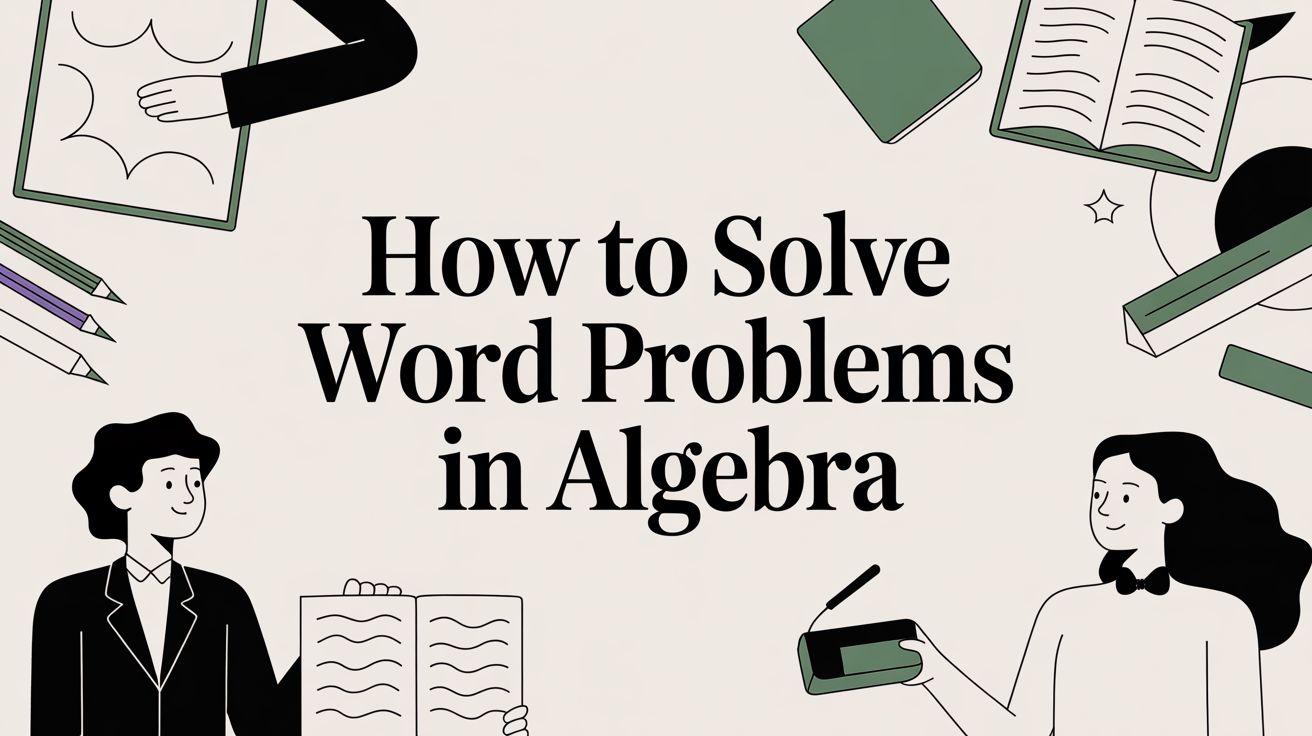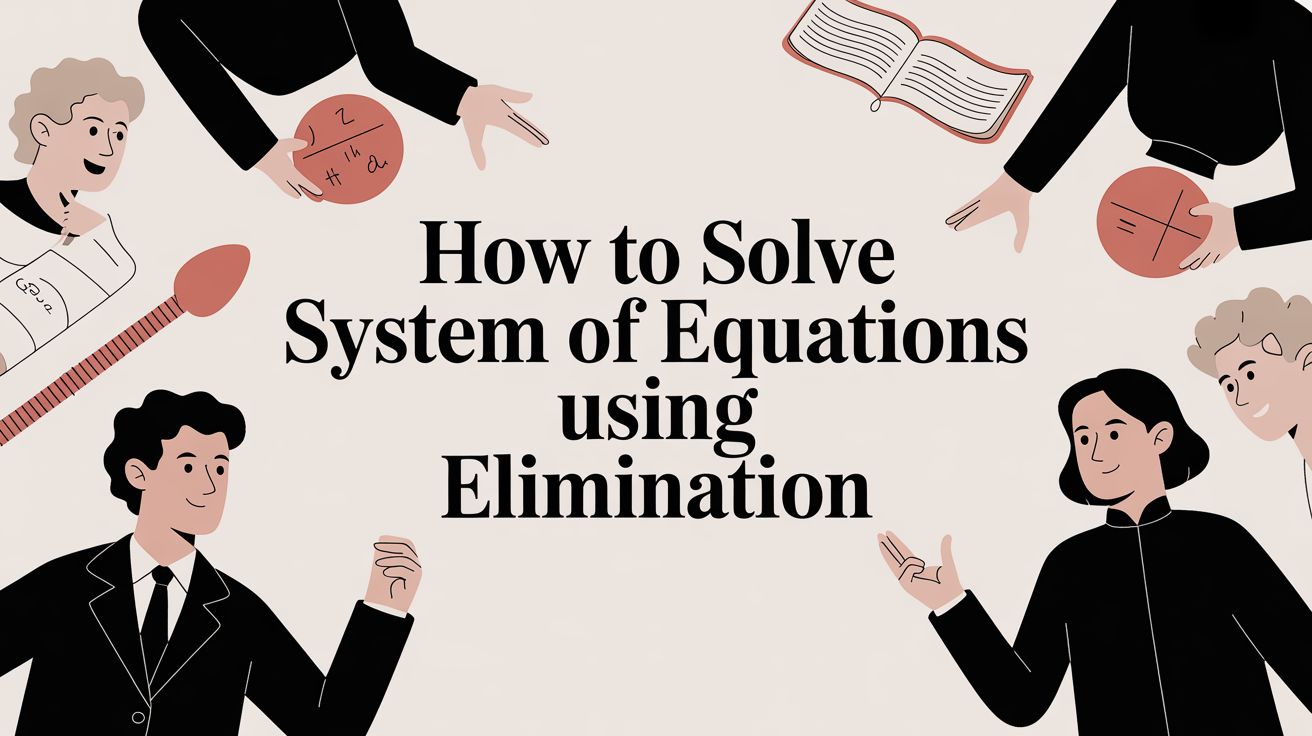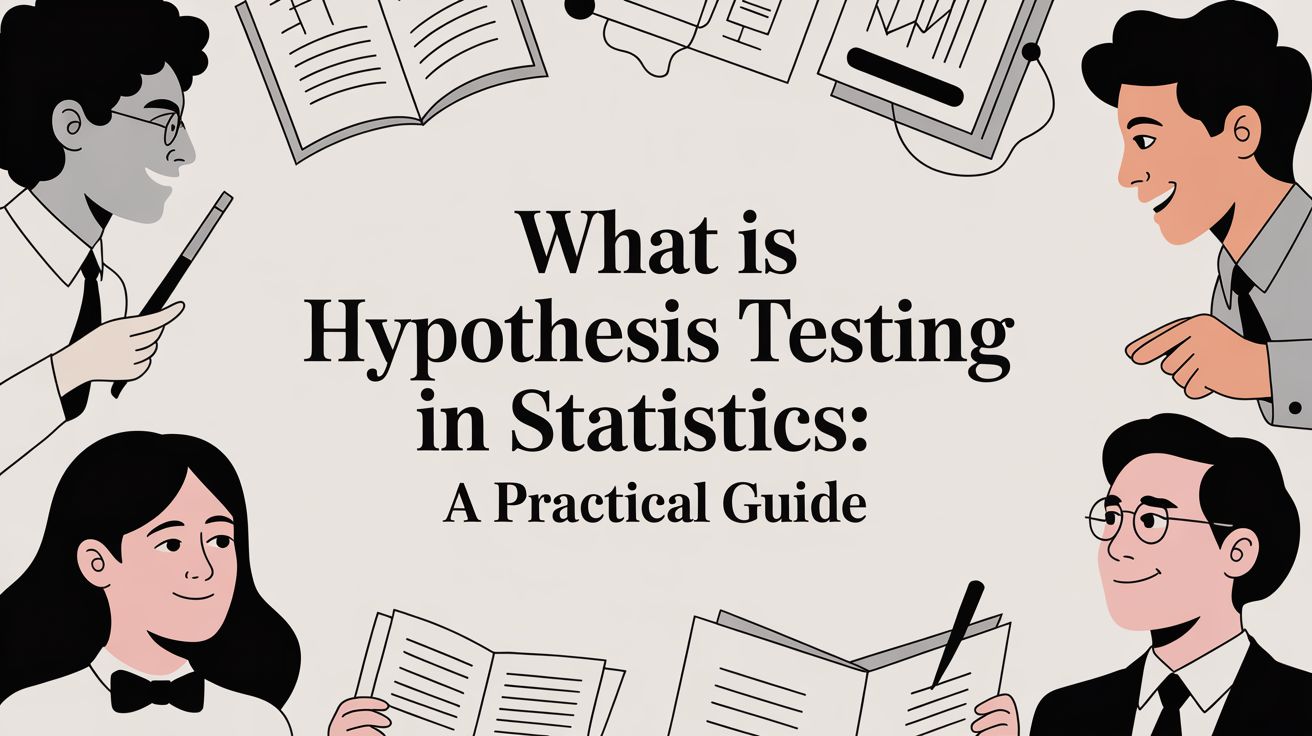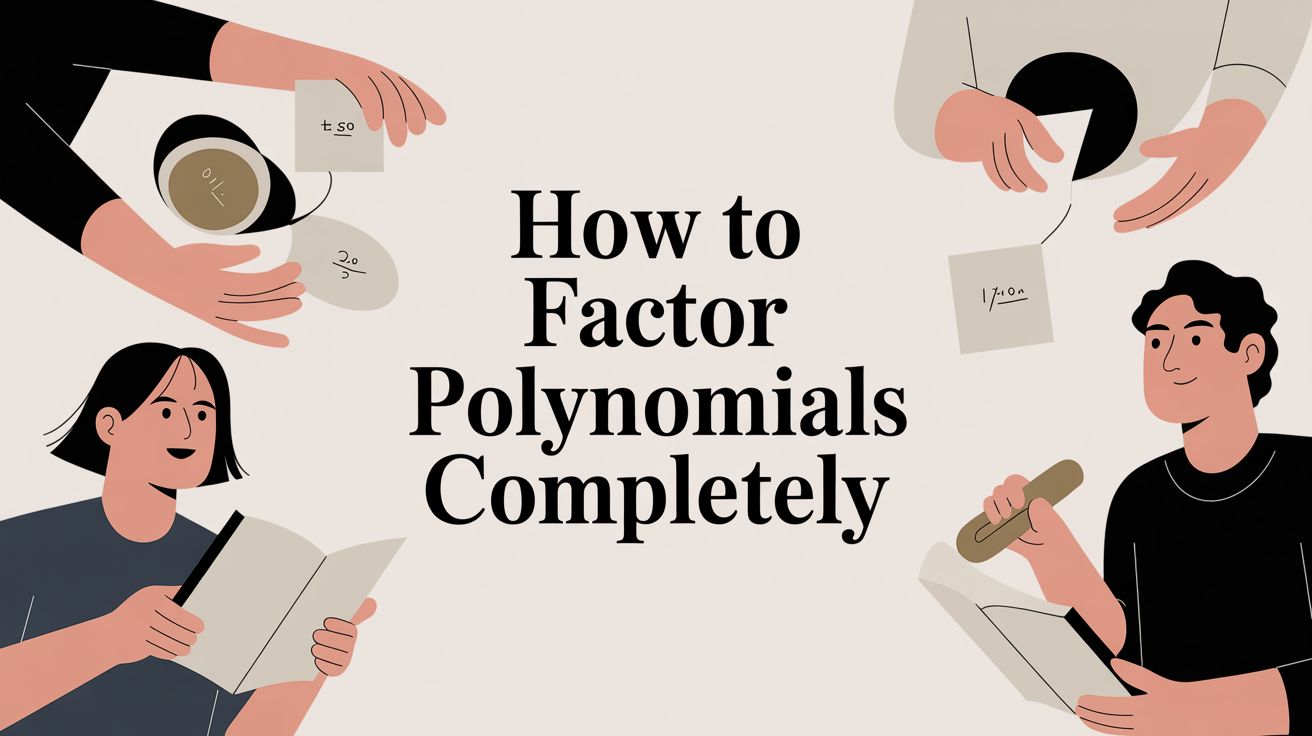8 Essential Math Problems for 2nd Graders (Practice Sets)
Discover our comprehensive roundup of math problems for 2nd graders, with free practice sets for addition, word problems, money, and more to boost skills.
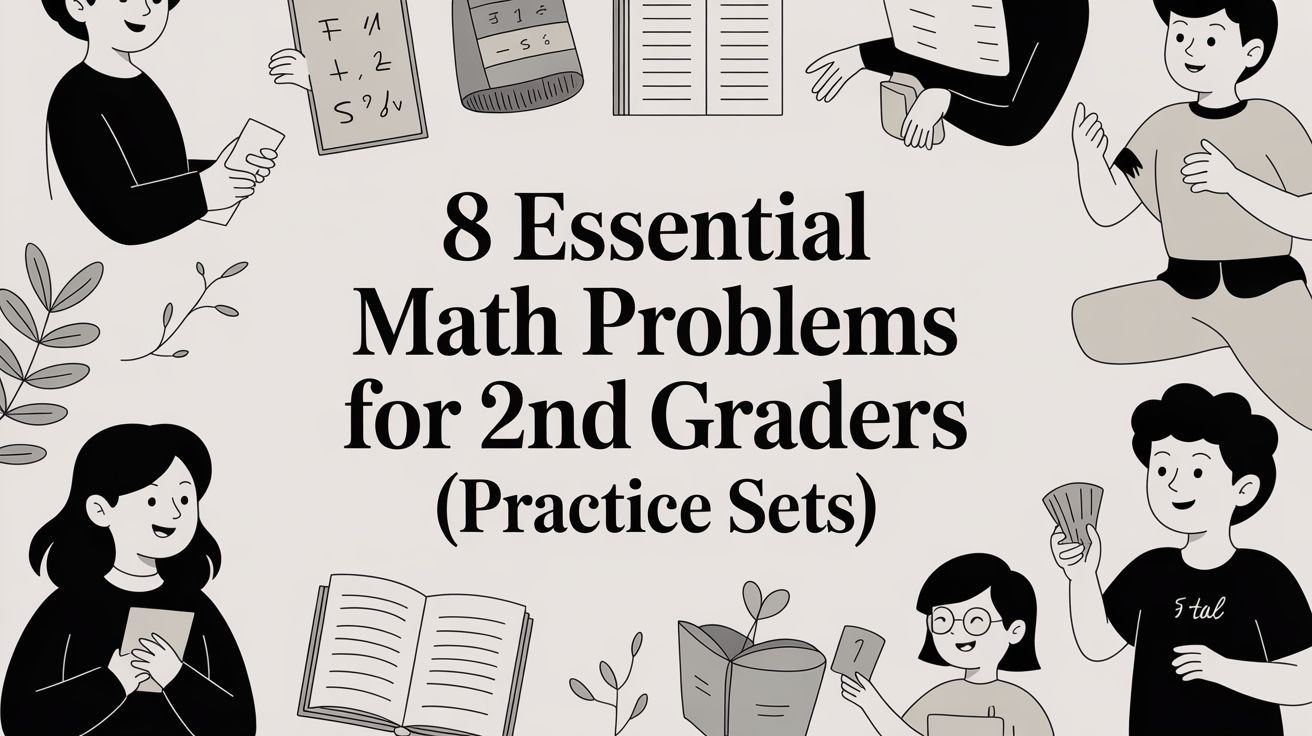
Second grade marks a crucial milestone in a child's mathematical journey, serving as the year where fundamental concepts take root and prepare them for more advanced topics. This is when students transition from simple counting to mastering two-digit addition and subtraction, understanding place value, and even exploring the initial building blocks of multiplication. To support this critical development, consistent and targeted practice is essential. Finding a comprehensive source of high-quality math problems for 2nd graders can be a time-consuming task for parents and educators alike.
This guide is designed to solve that problem. We have compiled a curated collection of practice sets, organized by the core skills every second grader needs to master. You will find ready-to-print worksheets, complete with answer keys and detailed solutions, covering everything from operational fluency to real-world applications.
Here’s a look at the key areas we cover:
- Addition and Subtraction: Building speed and accuracy with numbers up to 100.
- Word Problems: Translating real-world scenarios into mathematical equations.
- Foundations of Multiplication: Understanding equal groups and arrays.
- Measurement, Money, and Time: Applying math skills to practical, everyday situations.
- Data and Graphing: Learning to interpret and represent simple data sets.
Each section provides progressively challenging problems, teaching tips to guide your student, and explanations of how these skills align with common educational standards. Whether you are a parent supporting homework, a tutor seeking supplemental materials, or an educator planning lessons, this resource offers the specific, actionable math problems for 2nd graders needed to build a strong and confident foundation in mathematics.
1. Addition and Subtraction Within 20
Mastering addition and subtraction within 20 is the cornerstone of a 2nd grader's mathematical journey. This foundational skill involves adding and subtracting single-digit and small double-digit numbers where the result stays under 20. Achieving fluency here, as emphasized by Common Core standard 2.OA.B.2, is crucial for building the number sense required for more complex operations like multi-digit arithmetic and eventually multiplication. These aren't just abstract exercises; they represent the first step toward confident and capable mathematical thinking.
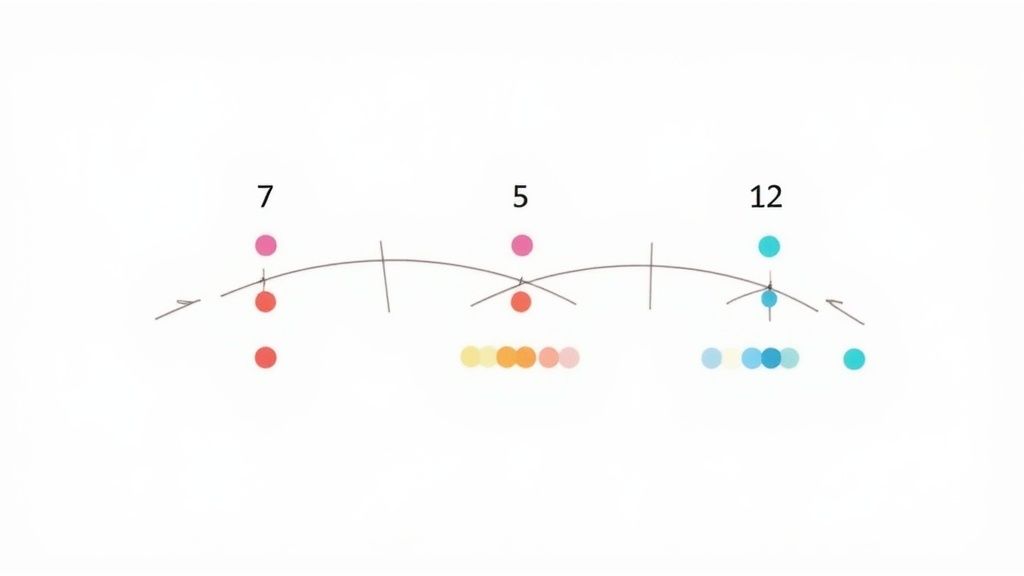
This focus on mastery is a core tenet of highly effective curricula like Singapore Math and Eureka Math. The goal is not just memorization but a deep, intuitive understanding of how numbers relate to each other. By working extensively with these basic math problems for 2nd graders, students learn to see patterns, decompose numbers (e.g., seeing 8 + 5 as 8 + 2 + 3), and develop mental math strategies that will serve them for years to come.
Why It Works
This approach builds automaticity. When a student can instantly recall that 9 + 7 = 16 or 15 - 8 = 7, their working memory is freed up to tackle more complex, multi-step problems. This prevents cognitive overload and builds confidence, reducing the likelihood of math anxiety. It’s the mathematical equivalent of learning sight words before reading a novel; you must know the basics to comprehend the bigger picture.
Actionable Tips for Implementation
To make this practice effective and engaging, integrate a variety of methods into daily routines.
- Use Physical Manipulatives: Don't just rely on worksheets. Use counting bears, base-ten blocks, or even simple items like buttons to help students visualize the process of combining or taking away quantities. This tangible connection is vital for concrete thinkers.
- Incorporate "Number Talks": Dedicate 10-15 minutes each day to discussing mental math strategies. Present a problem like 13 - 5 and ask students to share how they solved it. One might count back, another might subtract 3 to get to 10 and then subtract 2 more. This validates different ways of thinking and expands everyone's strategic toolkit.
- Mix Practice Types: Blend timed fact-fluency drills with untimed, problem-solving activities. Timed practice can build speed, but untimed work allows for deeper thinking and strategy development. To make these sessions more robust, you can learn more about how to study math effectively with proven techniques.
2. Word Problems with One-Step Operations
Word problems are where math meets the real world. For 2nd graders, one-step problems are a critical bridge between abstract calculation and practical application. These contextual challenges require students to read a scenario, identify the core question, and determine whether to use addition or subtraction to find the solution. This process moves beyond rote memorization, developing essential comprehension and critical thinking skills as students learn to translate language into mathematical expressions.
This emphasis on application is a hallmark of effective modern curricula, such as the problem-solving approach in Illustrative Mathematics and the model-drawing method popularized by Singapore Math. Instead of just solving 25 - 10, a student might be asked: "Maria had 25 crayons and gave 10 to her friend. How many crayons does Maria have left?" This small shift in presentation makes the math meaningful, answering the age-old question, "When will I ever use this?"
Why It Works
Word problems anchor mathematical concepts in reality, enhancing understanding and retention. They force students to slow down and think about what the numbers represent, preventing them from simply applying a memorized algorithm without comprehension. This builds a more robust and flexible understanding of math, as students learn to recognize the underlying structure of a problem regardless of the specific context or numbers involved. It's the first step in developing true mathematical reasoning.
Actionable Tips for Implementation
To build confidence and proficiency with these essential math problems for 2nd graders, focus on strategy and visualization.
- Encourage Drawing and Modeling: Before jumping to the equation, have students draw the problem. They can sketch out the objects, use bar models (a key feature of Singapore Math), or act it out with manipulatives. This visual step helps them internalize the situation.
- Identify "Signal" Words: Explicitly teach students to look for keywords that suggest an operation. Words like "in all," "altogether," and "total" often signal addition, while "left over," "how many more," and "fewer" typically indicate subtraction.
- Read Problems Aloud: Many students struggle with word problems due to reading challenges, not math deficits. Reading the problems aloud as a class or in small groups removes this barrier, allowing them to focus purely on the mathematical thinking required. To build their independent skills, you can explore guides on how to solve math problems step-by-step which often include strategies for deconstructing word problems.
3. Two-Digit Addition and Subtraction
Moving beyond single digits, two-digit addition and subtraction represent a significant leap in a 2nd grader's mathematical understanding. This skill involves adding and subtracting numbers up to 100, often requiring students to understand regrouping (carrying or borrowing). Mastering this, as outlined in Common Core standard 2.NBT.B.5, is the critical bridge from basic facts to complex, multi-digit operations. It’s where students truly begin to grasp the power and structure of our place value system.
This concept is a cornerstone of curricula like Singapore Math, which uses concrete-pictorial-abstract models to make regrouping tangible, and Everyday Mathematics, which employs tools like hundreds charts to build number sense. The goal is not just to teach a single, rigid algorithm but to develop computational fluency. By exploring various methods for solving problems like 45 + 28 or 72 - 39, students learn that there are multiple pathways to a correct answer, fostering a more flexible and resilient approach to problem-solving. These types of math problems for 2nd graders are essential for building a solid arithmetic foundation.
Why It Works
This skill solidifies a student's understanding of place value. When a student regroups to solve 56 + 27, they must understand that 6 + 7 equals 13, which is one ten and three ones. This act of "carrying the one" is a profound conceptual step, cementing the idea that the position of a digit determines its value. This prevents future difficulties with larger numbers, multiplication, and decimals, as the underlying logic remains the same. It transforms math from a set of memorized steps into a logical system.
Actionable Tips for Implementation
To build a deep and lasting understanding of two-digit operations, use a multi-faceted, hands-on approach.
- Start with Base-Ten Blocks: Before introducing the abstract algorithm on paper, have students physically model problems with base-ten blocks. Let them trade ten "ones" blocks for one "tens" rod. This tangible experience makes the concept of regrouping intuitive and clear.
- Teach Multiple Strategies: Don't force one method. Introduce different strategies like using a hundreds chart or a number line to "jump" by tens and then ones. Also, teach decomposing numbers (e.g., solving 43 + 38 by adding 40+30 and 3+8). This shows students that math is flexible and creative.
- Master "Without Regrouping" First: Build confidence by starting with problems that do not require carrying or borrowing, such as 34 + 21 or 68 - 15. Once students are comfortable with the place value mechanics, introduce the added complexity of regrouping. This scaffolding approach prevents overwhelm and reduces math anxiety.
4. Equal Groups and Arrays (Foundations of Multiplication)
While formal multiplication is a third-grade topic, second graders lay the essential groundwork by exploring the concept of equal groups. This involves understanding that multiplication is essentially repeated addition, a big idea that transforms how students see numbers. These foundational math problems for 2nd graders, as outlined in standard 2.OA.C.4, ask students to determine if a group has an odd or even number of members and to express an even number as a sum of two equal addends. This sets the stage for a deep, conceptual grasp of multiplication.

Curricula like Eureka Math (Module 6) dedicate significant time to this very topic, using arrays and equal groups to make the abstract idea of multiplication concrete. Students don't just memorize facts; they build, draw, and describe what "3 groups of 4" actually looks like. This visual and hands-on approach ensures they understand the why behind the operation, not just the how of getting an answer. It is a critical bridge from additive to multiplicative thinking.
Why It Works
This approach prevents the common pitfall of students memorizing multiplication facts without understanding what they represent. By working with arrays (arrangements of objects in rows and columns) and equal groups, students see the commutative property (3 groups of 4 is the same as 4 groups of 3) in action long before they learn the term. This strong conceptual foundation makes learning the formal algorithm for multiplication in later grades much more intuitive and less prone to errors. It connects counting, addition, and multiplication into one cohesive narrative.
Actionable Tips for Implementation
To build these foundational skills effectively, focus on hands-on and visual activities.
- Use Physical Objects: Move beyond worksheets by having students create equal groups with counters, blocks, or even snacks like crackers. Ask them to build an array showing 4 rows of 5, then write the corresponding repeated addition sentence (5 + 5 + 5 + 5).
- Draw and Visualize: Give students grid paper to draw their own arrays. This helps them organize their thinking and reinforces the structure of rows and columns. Connect this to real-world examples, like eggs in a carton or panes of glass in a window.
- Connect to Skip Counting: Practice skip-counting songs and chants by 2s, 5s, and 10s. Explicitly link this to the concept of equal groups. For example, as you count by 5s, point to groups of 5 objects to show the total accumulating. To make learning the foundations of multiplication engaging, children can benefit from interactive activities such as Kirby's Multiplication Adventure.
5. Measurement and Comparison Problems
Measurement and comparison problems ground mathematical concepts in the physical world, making abstract numbers tangible and relevant for second graders. This area of study involves measuring attributes like length, weight, and volume using both standard (inches, centimeters) and non-standard units (paper clips, blocks). It also includes comparing these measurements, which directly supports the development of spatial reasoning and an understanding of inequalities (greater than, less than), a key component of the 2.MD standards.

This hands-on approach is a hallmark of curricula like Investigations in Number, Data, and Space and Everyday Mathematics, which emphasize learning through exploration. By engaging in these types of math problems for 2nd graders, students don't just learn how to measure; they discover why standard units are necessary and how measurement connects directly to addition and subtraction when they calculate differences between two lengths.
Why It Works
This approach makes math practical and observable. When a student measures their desk with paper clips and then with a ruler, they build a concrete understanding of units and scale. This process enhances number sense and estimation skills, as students learn to predict an object's size before measuring it. It transforms math from a purely academic exercise into a tool for understanding and describing their immediate environment, which boosts engagement and retention.
Actionable Tips for Implementation
To build a strong foundation in measurement, focus on hands-on activities and comparative language.
- Start with Non-Standard Units: Before introducing rulers and measuring tapes, have students measure classroom objects with items like linking cubes, crayons, or their own footsteps. This helps them grasp the core concept of iterating a unit without the complexity of standard markings.
- Emphasize Estimation: Before every measurement activity, ask students to estimate the length or weight. "How many blocks long do you think this book is?" This simple step encourages them to visualize quantities and develops their number sense.
- Create Anchor Charts: Visually document measurement strategies and unit comparisons (e.g., pictures showing that a foot is longer than an inch). These charts serve as constant visual aids that reinforce key concepts and vocabulary.
- Connect to Comparisons: Always follow up measurement with comparison. Ask questions like, "Which is longer, the pencil or the crayon? By how much?" This directly links measurement (2.MD.A.1) with comparing numbers (2.NBT.A.4) and using operations to find the difference (2.MD.B.5).
6. Money Problems (Counting Coins and Making Change)
Connecting math to the real world is essential for 2nd graders, and nothing does this better than money problems. These tasks involve identifying U.S. coins, counting their values, and solving simple problems about buying items and making change. This skill directly applies addition, subtraction, and skip-counting, turning abstract operations into tangible, everyday transactions. Aligned with standards like 2.MD.C.8, these problems build a foundation for financial literacy and reinforce number sense in a practical context.
This practical approach is a hallmark of curricula like Saxon Math and Everyday Mathematics, which integrate money skills throughout their lessons. Instead of treating it as an isolated unit, they use money to continuously reinforce other mathematical concepts. By engaging with these types of math problems for 2nd graders, students don't just learn to count; they learn to strategize, combine different values (a quarter and two dimes), and think flexibly about numbers.
Why It Works
Money problems make math relevant and concrete. When a student has to figure out if they have enough money to "buy" a toy from a classroom store, the calculation has an immediate and understandable purpose. This real-world application boosts engagement and helps students see the "why" behind their learning. It transforms skip-counting by 5s and 10s from a rote exercise into a useful tool for quickly counting nickels and dimes, strengthening both procedural fluency and conceptual understanding.
Actionable Tips for Implementation
To make learning about money effective, hands-on experience is non-negotiable.
- Use Real or Realistic Coins: The tactile experience of handling coins is invaluable. Provide students with real coins or high-quality plastic manipulatives. The different sizes, weights, and textures help anchor the value of each coin in their memory.
- Create a Classroom Store: Set up a simple "store" with priced items (e.g., pencils, erasers). Give students a set amount of play money and have them practice purchasing items and calculating their change. This role-playing makes practice authentic and fun.
- Practice Foundational Skills First: Before tackling complex money problems, ensure students are fluent in skip-counting by 5s, 10s, and 25s. Use anchor charts that clearly display each coin, its name, and its value to provide a constant visual reference.
7. Time-Telling and Duration Problems
Understanding how to tell time is a fundamental life skill, and for 2nd graders, it represents a significant step into applying abstract math concepts to the real world. This skill involves reading analog and digital clocks to the nearest five minutes (as per Common Core standard 2.MD.C.7) and solving simple problems about time duration. These math problems for 2nd graders go beyond just reading numbers; they build temporal reasoning, helping students understand schedules, sequences of events, and the passage of time.
Curricula like Eureka Math and Everyday Mathematics dedicate specific modules to time, recognizing its importance in daily life. The goal is to connect the abstract concept of hours and minutes to a student's own experience, such as knowing what time recess starts or when school ends. This practical application makes the learning process more meaningful and helps students see math as a tool for navigating their day.
Why It Works
Time-telling problems strengthen number sense, particularly counting by fives and understanding the base-60 system, which is different from the base-10 system they use for most other math. This new context challenges them to think flexibly about numbers and units. When students solve problems like, "If soccer practice starts at 3:00 and lasts for one hour, what time does it end?" they are practicing addition in a real-world scenario, laying the groundwork for more complex elapsed time calculations in later grades.
Actionable Tips for Implementation
To build a strong foundation in time-telling, use a multi-faceted and hands-on approach.
- Connect to a Daily Schedule: Make time a visible and interactive part of the classroom routine. Create a large anchor chart with the daily schedule, featuring both analog and digital clock faces for key activities like lunch, math, and dismissal. Refer to it often throughout the day.
- Use Both Analog and Digital Clocks: Explicitly teach the relationship between analog and digital formats. Have students match times on a worksheet or with physical clocks. This helps them understand that 2:30 and "half-past two" represent the same moment in time.
- Start Simple and Build Complexity: Begin by ensuring mastery of the hour and half-hour. Once students are confident, introduce counting by fives to read time to the nearest five minutes. Use practice clocks where students can physically move the hands to build a kinesthetic understanding of how the hour and minute hands move in relation to one another.
8. Data Interpretation and Graphing Problems
Introducing 2nd graders to data interpretation and graphing transforms abstract numbers into visual, meaningful stories. These math problems for 2nd graders involve collecting data, organizing it, and representing it through simple pictographs and bar graphs. This skill set, highlighted in standards like 2.MD.D.10, develops foundational statistical thinking and teaches students how to extract and communicate information from visual formats. It’s a critical bridge between mathematics and real-world inquiry, turning everyday questions into opportunities for analysis.
Curricula like Investigations in Number, Data, and Space and Everyday Mathematics place a strong emphasis on these skills for good reason. When students survey their classmates about favorite animals and then build a graph to show the results, they are not just counting; they are organizing information, comparing quantities, and drawing conclusions. This process makes math relevant and engaging, showing students how numbers can answer questions about their own world.
Why It Works
This approach builds crucial analytical skills. Instead of just solving an equation, students learn to pose a question, collect relevant data, represent it clearly, and interpret the results. This multi-step process strengthens logical reasoning, organizational skills, and the ability to see relationships between different pieces of information. It prepares them for more complex data analysis in later grades and helps them become more critical consumers of information they encounter everywhere, from news reports to advertisements.
Actionable Tips for Implementation
To successfully integrate data and graphing, make the process hands-on and student-centered.
- Start with Class-Generated Data: Begin with topics that are familiar and exciting to students, like favorite foods, colors, or pets. Use a simple poll to collect the data, making every student a contributor to the mathematical investigation.
- Use Concrete Objects First: Before drawing a graph on paper, represent the data with physical items. For example, if surveying favorite fruits, have students place a colored block in a column for their choice. This tangible representation helps them see the quantities build up before moving to abstract pictographs or bar graphs.
- Ask Varied Questions: Once a graph is created, guide interpretation with a range of questions. Go beyond "Which has the most?". Ask, "How many more students chose dogs than cats?" or "How many students voted in total?". This pushes them to compare, combine, and analyze the data more deeply. For more educational insights, you can explore our blog for related topics.
8-Point Comparison of 2nd-Grade Math Problem Types
| Item | Implementation complexity | Resource requirements | Expected outcomes | Ideal use cases | Key advantages |
|---|---|---|---|---|---|
| Addition and Subtraction Within 20 | Low | Worksheets, optional manipulatives/number lines | Automaticity with basic facts; stronger number sense | Daily fluency practice, warm-ups, remediation | Builds foundational skills; easy to differentiate |
| Word Problems with One-Step Operations | Low–Medium | Text/illustrations; reading supports and visual aids | Ability to translate text to operations; improved comprehension | Contextual learning, assessing applied understanding | Connects math to real life; integrates reading/math |
| Two-Digit Addition and Subtraction | Medium | Base-ten blocks, place-value charts, guided practice | Place-value understanding; multi-digit computation skills | Transition to multi-digit arithmetic; strategy instruction | Deepens place value; supports multiple strategies |
| Equal Groups and Arrays (Foundations of Multiplication) | Medium | Manipulatives, grid paper, counters | Conceptual foundation for multiplication; skip-counting | Preparation for multiplication; visual/spatial learners | Builds conceptual models; links repeated addition to multiplication |
| Measurement and Comparison Problems | Medium | Rulers, scales, measuring cups, classroom objects | Practical measurement skills; spatial reasoning | Cross-curricular investigations, hands-on labs | Tangible, real-world applications; engages kinesthetic learners |
| Money Problems (Counting Coins and Making Change) | Low–Medium | Real or plastic coins, price cards, coin mats | Coin recognition, counting mixed collections, basic change skills | Classroom store, role-play, authentic practice | Highly engaging; teaches financial literacy foundations |
| Time-Telling and Duration Problems | Medium | Analog and digital clocks, practice worksheets | Read time to hour/half-hour; basic elapsed time reasoning | Daily schedule activities, predicting durations | Teaches essential daily-life skill; links routines to math |
| Data Interpretation and Graphing Problems | Medium | Chart paper, tally tools, graphing templates | Collecting, representing, and interpreting simple data | Class surveys, science integration, collaborative projects | Promotes inquiry, communication, and analytical thinking |
From Practice to Proficiency: Next Steps in 2nd Grade Math
Navigating the world of second-grade mathematics is a journey of building fundamental blocks, one concept at a time. Throughout this article, we've explored a comprehensive collection of math problems for 2nd graders, moving from foundational skills like addition and subtraction within 20 to more complex applications involving measurement, money, and data interpretation. The key takeaway is that proficiency isn't achieved through a single worksheet; it’s cultivated through consistent, varied, and engaging practice.
By working through the different problem types presented, from one-step word problems to the foundational arrays of multiplication, you are helping your second grader build more than just computational speed. You are fostering critical thinking, logical reasoning, and the crucial ability to connect abstract numbers to tangible, real-world scenarios. This connection is what transforms math from a list of rules into a powerful tool for understanding the world.
Key Takeaways for Fostering Math Mastery
To ensure these lessons stick, it's vital to move beyond rote memorization and focus on genuine understanding. Remember these core principles as you continue to support your learner:
- Variety is Essential: Don't rely solely on one type of problem. Mix and match word problems, visual exercises (like arrays and graphs), and hands-on activities with coins or rulers. This variety keeps learning fresh and demonstrates how a single math concept can be applied in many different ways.
- Celebrate the Process, Not Just the Answer: Math can be challenging. When a child gets stuck, praise their effort, their persistence, and their willingness to try a different strategy. Shifting the focus from "getting it right" to "figuring it out" builds resilience and a positive mathematical mindset.
- Make It Real: The most impactful learning happens when children see the "why" behind the math. Use problems that reflect their daily lives. How much money do they need to buy a favorite snack? How much longer until their favorite TV show starts? These practical questions make math relevant and meaningful.
Actionable Next Steps for Continued Growth
Your role as a guide is pivotal. Here are some actionable steps you can take to build on the foundation laid by these practice problems and ensure your second grader continues to flourish:
- Revisit and Reinforce: Periodically circle back to earlier concepts. A quick review of two-digit addition can reinforce place value understanding before tackling more complex problems. Regular, low-stakes review is more effective than cramming.
- Integrate Math into Daily Routines: Turn everyday activities into learning opportunities. Ask your child to help measure ingredients while cooking, count change at the grocery store, or read the time on an analog clock. This seamless integration reinforces skills in a natural context.
- Gamify the Practice: Learning should be enjoyable. For an interactive and modern approach to practicing math skills and reinforcing what they've learned, consider incorporating engaging online math games. Games can provide repetitive practice in a format that feels like play, boosting both skill and confidence.
- Embrace Supportive Technology: When you or your child encounter a particularly tricky problem from a worksheet or homework assignment, don't let frustration take over. Use tools like Feen AI to get instant, step-by-step guidance. This isn't about getting the answer; it's about understanding the process to solve similar math problems for 2nd graders independently in the future.
Ultimately, the goal is to nurture a confident and curious problem-solver. By providing a rich variety of challenges, celebrating every small victory, and connecting mathematical concepts to the world around them, you are setting your second grader up for a lifetime of success, both in and out of the classroom.
Struggling to explain a tough math problem? Get instant, step-by-step help with Feen AI. Simply snap a photo of any problem, and our AI tutor will walk your child through the solution, reinforcing learning and building confidence. Try Feen AI today and turn frustration into understanding.
Recent articles
Discover the 12 best AI homework helper apps for 2025. Compare features, pricing, and use cases to find the perfect tool for any subject and level.
Learn how to solve word problems in algebra using practical strategies. This guide breaks down the process with real examples and tips to build your confidence.
Master how to solve system of equations using elimination with clear examples, practical advice, and expert tips in this comprehensive guide.
how to solve a system of equations: master the method with step-by-step examples and practical tips
Discover what is hypothesis testing in statistics and how it works, with clear steps, core concepts, and practical examples to draw valid conclusions from data.
Learn how to factor polynomials completely using our guide. From GCF to advanced methods, we'll help you solve any algebra problem with confidence.

